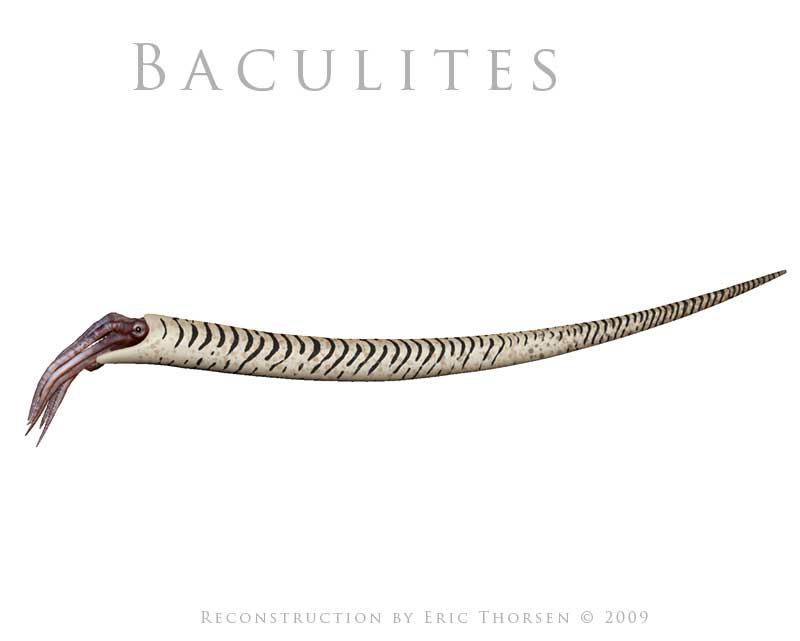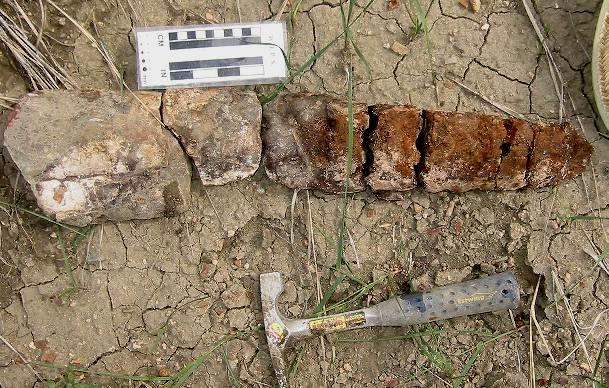[Recent Entries][Archive][Friends][User Info]
| Time | Text |
|---|---|
| 07:56 pm [Link] |
Baculites Baculites ("walking stick rock") is an extinct cephalopod genus with a nearly straight shell that is included in the heteromorph ammonites. The genus, which lived worldwide throughout the Late Cretaceous period, was named by Jean Baptiste Lamarck in 1799. The adult shell of Baculites is generally straight and may be either smooth or with sinuous striae or ribbing that typically slant dorso-ventrally forward. The aperture likewise slopes to the front and has a sinuous margin. The venter is narrowly rounded to acute while the dorsum is more broad. The juvenile shell, found at the apex, is coiled in one or two whorls and described as minute, about a centimeter in diameter. Adult Baculites ranged in size from about seven centimeters (Baculites larsoni) up to two meters in length. As with other ammonites, the shell consisted of a series of camerae, or chambers, that were connected to the animal by a narrow tube called a siphuncle by which gas content and thereby buoyancy could be regulated in the same manner as Nautilus does today. The chambers are separated by walls called septa. The line where each septum meets the outer shell is called the suture or suture line. Like other true ammonites, Baculites have intricate suture patterns on their shells that can be used to identify different species. One notable feature about Baculites is that the males may have been a third to a half the size of the females and may have had much lighter ribbing on the surface of the shell. The shell morphology of Baculites with slanted striations or ribbing, similarly slanted aperture, and more narrowly rounded to acute keel-like venter points to its having had a horizontal orientation in life as an adult. This same type of cross section is found in much earlier nautiloids such as Bassleroceras and Clitendoceras from the Ordovician period, which can be shown to have had a horizontal orientation. In spite of this, some researchers have concluded that Baculites lived in a vertical orientation, head hanging straight down, since lacking an apical counterweight, movement was largely restricted to that direction. More recent research, notably by Gerd Westermann, has reaffirmed that at least some Baculites species in fact lived in a more or less horizontal orientation. From shell isotope studies, it is thought that Baculites inhabited the middle part of the water column, not too close to either the bottom or surface of the ocean. In some rock deposits Baculites are common, and they are thought to have lived in great shoals. However, they are not known to occur so densely as to be rock-forming, as do certain other extinct, straight-shelled cephalopods (e.g., orthocerid nautiloids). Baculites fossils are very brittle and almost always break. They are most commonly found broken in half or several pieces, usually along suture lines. Individual chambers found this way are sometimes referred to as "stone buffaloes" (due to their shapes), though the Native-American attribution typically given as part of the story behind the name is likely apocryphal. Baculites and related Cretaceous straight ammonite cephalopods are often confused with the superficially similar orthocerid nautiloid cephalopods. Both are long and tubular in form, and both are common items for sale in rock shops (often under each others' names). Both lineages evidently evolved the tubular form independently, and at different times in earth history. The orthocerid nautiloids lived much earlier (common during the Paleozoic Era and extinct by the end of the Triassic Period) than Baculites (Late Cretaceous Period only). The two types of fossils can be distinguished by many features, most obvious among which is the suture line: it is simple in orthocerid nautiloids and intricately folded in Baculites and related ammonoids. Studies on exceptionally preserved specimens have revealed a radula by synchrotron imagery. The results suggest that Baculites fed on pelagic zooplankton (as suggested by remains of a larval gastropod and a pelagic isopod inside the mouth).
Ископаемые останки (1, 2, 3, 4, 5):
|
| Reply: | |








